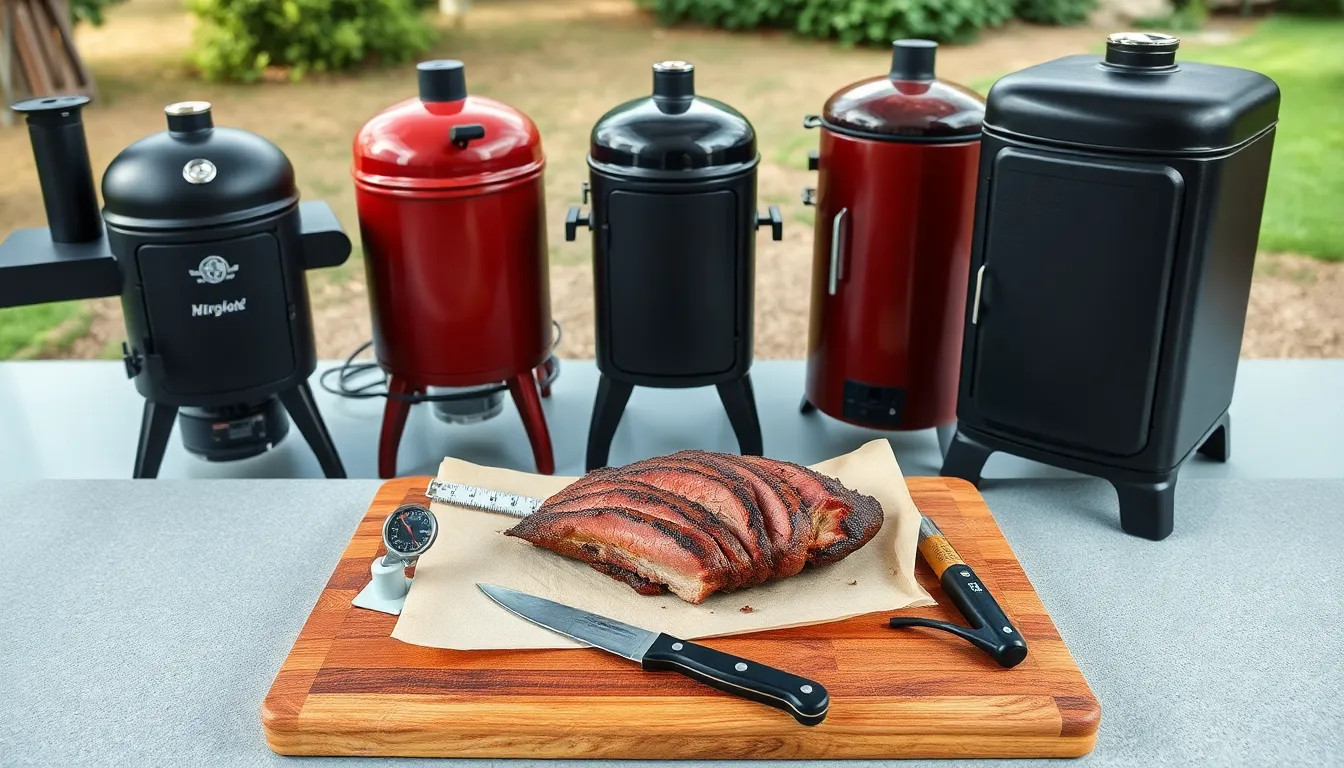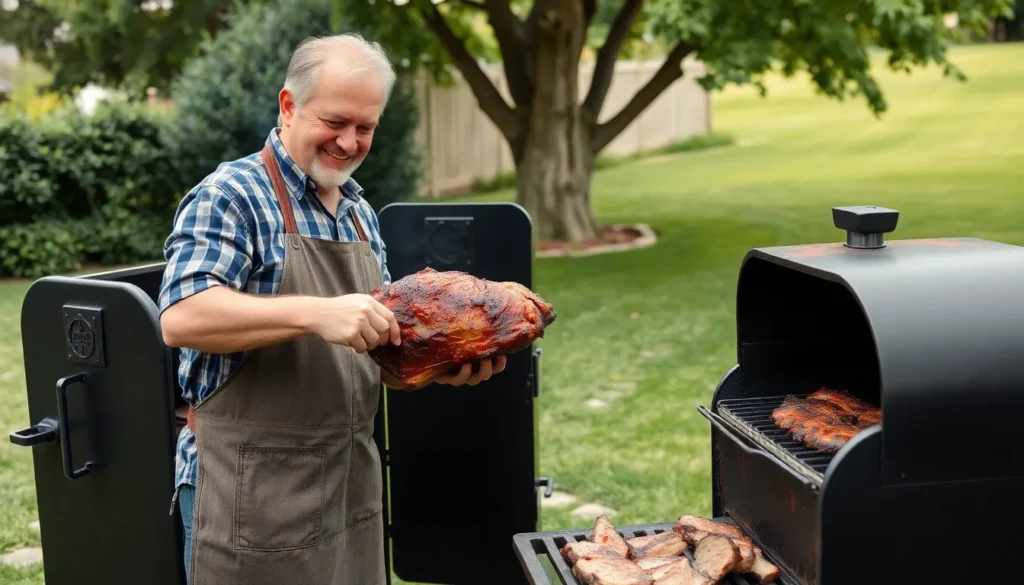Table of Contents
ToggleIf there’s one thing that can turn a backyard barbecue into a legendary feast, it’s a perfectly smoked brisket. Imagine that tender, juicy meat just falling apart at the slightest touch. Sounds delicious, right? But before you can reach that meaty nirvana, you need to master the art of brisket prep.
Understanding Brisket Cuts
Brisket consists of two main cuts, each offering distinct textures and flavors. Knowledge of these cuts helps in selecting the best option for smoking.
Flat vs. Point
Flat cut represents the leaner portion, known for its uniform shape. This cut cooks evenly and typically slices well. Point cut contains more marbling, resulting in a richer flavor and tenderness. Smokers often prefer point cut for its juicy texture and depth of taste. Both cuts require different cooking techniques, which influence seasoning and smoke absorption.
Choosing the Right Cut
Selection depends on personal preference and desired end result. Flat cut suits those seeking leaner meat, while point cut appeals to flavor enthusiasts. Consider size, as brisket generally weighs between 10 to 20 pounds. Choosing a grade of meat, such as USDA Choice or Prime, impacts taste and tenderness. Inspect the cut for marbling; more fat enhances flavor during smoking.
Essential Tools and Ingredients

Preparing a brisket for smoking requires specific tools and ingredients to achieve optimal results. Attention to detail makes a significant difference in flavor and tenderness.
Smoker Options
Choosing the right smoker impacts the smoking process and final taste. Offset smokers offer versatility and control over the heat levels. Vertical smokers ensure even cooking and require less space. Electric smokers provide a set-it-and-forget-it experience, which is convenient for beginners. Pellet smokers combine convenience and flavor, utilizing wood pellets for heat and smoke. Each type brings unique characteristics to the smoking experience.
Must-Have Supplies
Several essential supplies simplify the brisket preparation process. A sharp knife for trimming ensures clean cuts and helps manage fat layers effectively. A stable cutting board provides a secure surface for prepping the brisket. Quality butcher paper or foil aids in wrapping during cooking, preserving moisture and tenderness. A meat thermometer accurately gauges internal temperature for doneness. Additionally, a marinade injector enhances flavor infusion, allowing for deeper seasoning throughout the meat. Gathering these supplies aids in preparing a perfect brisket for smoking.
Preparing the Brisket
Preparing the brisket involves essential steps that enhance flavor and texture before smoking. Attention to these details leads to a superior final result.
Trimming the Fat
Trimming the fat from the brisket plays a critical role in the cooking process. Remove excess fat, particularly from the thick layer on the top, leaving about a quarter-inch of fat. This thickness retains moisture during smoking while allowing the seasoning to penetrate. Avoid cutting too much fat from the flat cut, as lean meat can dry out quickly. Focus on the crevices where silver skin and hard fat reside, as these elements prevent even cooking. Proper trimming results in a more balanced flavor, promoting tenderness as the fat renders during the smoking process.
Applying the Rub
Applying the rub effectively enhances the brisket’s flavor profile. Choose a blend of coarse salt, black pepper, and optional spices like paprika or garlic powder for a robust taste. Generously apply the rub over the entire surface of the meat, ensuring even coverage on all sides. Let the brisket rest for at least one hour, allowing the rub to adhere and develop flavor. For more depth, consider wrapping the brisket in plastic wrap and refrigerating it overnight. This resting period intensifies the flavors, leading to a more enjoyable smoked brisket that captivates taste buds.
Smoking Process
The smoking process is crucial for transforming a prepared brisket into a flavorful masterpiece. Several factors significantly influence the outcome, particularly temperature control and timing techniques.
Temperature Control
Temperature control is vital for achieving perfect brisket. The smoker should maintain a steady temperature of around 225°F to 250°F. Heating it within this range allows the meat to cook evenly. A reliable meat thermometer ensures optimal monitoring of the internal temperature, ideally aiming for around 195°F to 205°F in the brisket. The collagen in the meat breaks down during this range, resulting in tenderness. Maintaining consistent temperatures throughout the smoking process greatly enhances flavor and texture.
Timing and Techniques
Timing and techniques play significant roles in brisket smoking. Generally, allow approximately 1.5 hours of cooking time per pound of brisket. This guideline aids in planning and ensures the meat receives adequate smoking time. Using wood chips like hickory, oak, or mesquite adds distinct flavors. Slicing the brisket against the grain after a resting period of at least 30 minutes enhances juiciness and makes each bite tender. Applying techniques such as spritzing the meat with a mixture of apple cider vinegar and water can keep the brisket moist throughout the smoking process.
Resting and Slicing
Resting the brisket after smoking is essential for optimal flavor and tenderness. Allow the brisket to rest for a minimum of 30 minutes to 1 hour. This period lets the juices redistribute throughout the meat, resulting in a more succulent bite. Wrapping the brisket in butcher paper helps retain heat and moisture during the resting phase. Some experts recommend wrapping it in a towel and placing it in a cooler for further insulation without continued cooking. Monitoring the temperature can help ensure it remains warm but doesn’t overcook.
Resting Period
The resting period significantly impacts the final outcome. During this time, the fibers relax, leading to juicier slices. Foil or butcher paper wrapping minimizes moisture loss. Heed the importance of patience; allowing the brisket to relax ensures that every bite remains tender and flavorful. It’s common to lose 5% to 10% of the initial weight in juices if sliced too early. Relying on proper resting techniques results in a mouthwatering experience.
Proper Slicing Techniques
Slicing the brisket against the grain enhances tenderness. Identifying the muscle fibers makes this task straightforward. A sharp knife ensures clean cuts, minimizing shredded pieces. Cutting in even portions, typically around 1/4-inch thick, allows for easy serving. Utilize a cutting board to provide stability and prevent slips. It’s advisable to sample a slice before plating to gauge flavor and tenderness. Following these techniques ultimately contributes to a remarkable presentation and delightful taste.
Preparing a brisket for smoking is an art that can transform any gathering into a memorable feast. By understanding the nuances of different cuts and mastering essential techniques, anyone can achieve that tender and juicy result.
The right tools and ingredients play a significant role in enhancing flavor and ensuring a successful smoking process. Maintaining proper temperature and timing is crucial for achieving the perfect doneness.
Finally, allowing the brisket to rest and using proper slicing techniques can elevate the final presentation and taste. With these steps in mind, anyone can confidently create a mouthwatering smoked brisket that leaves a lasting impression.




